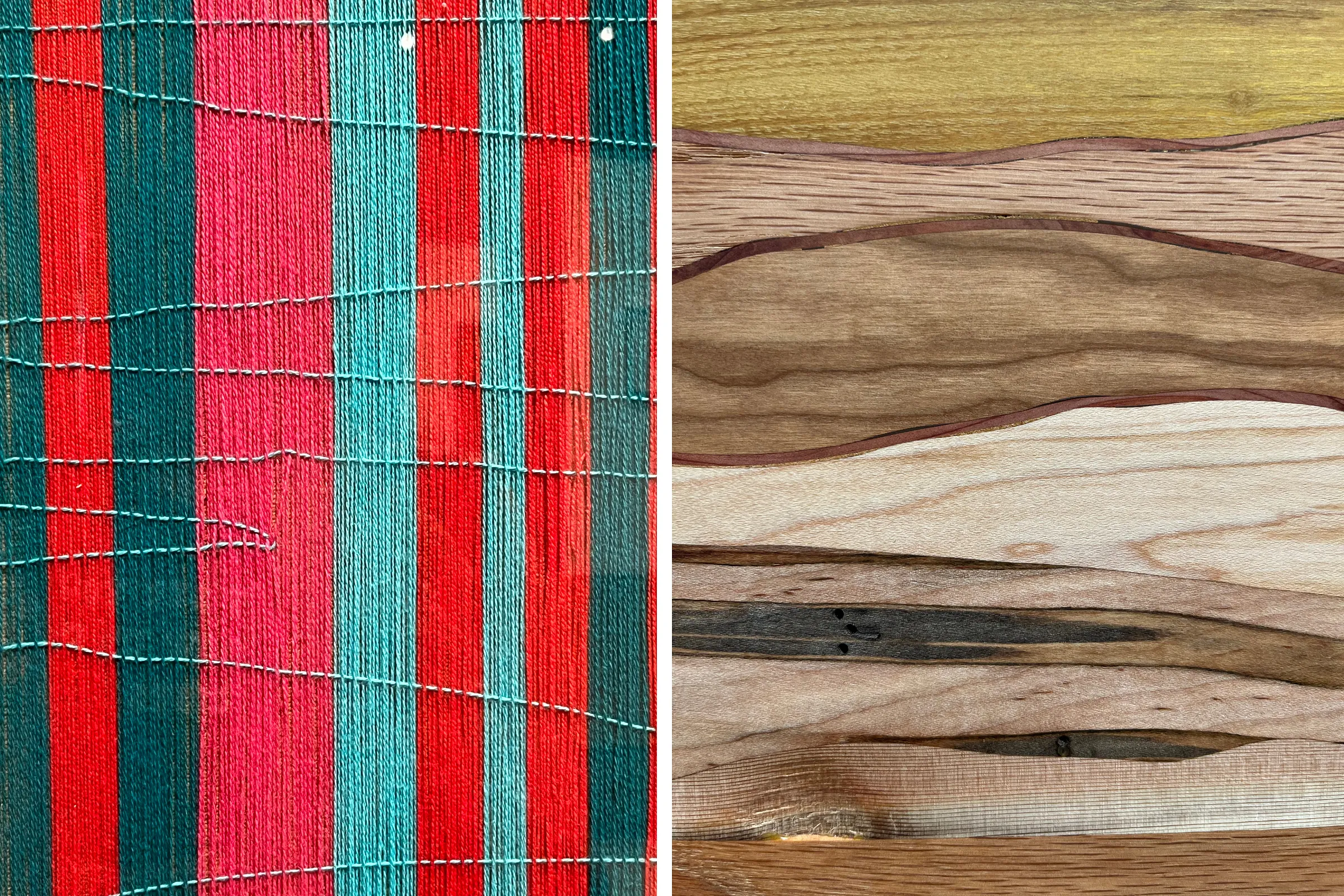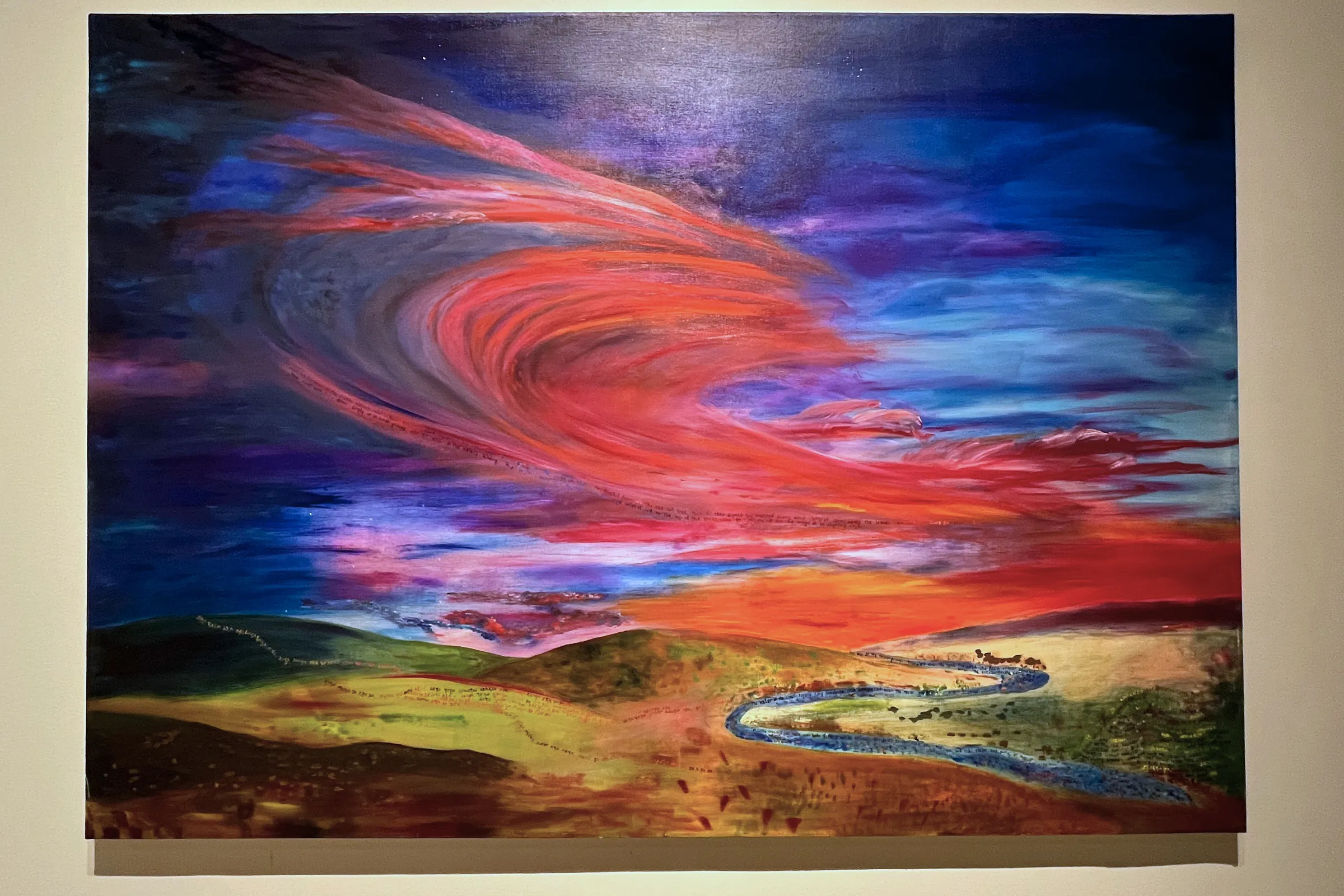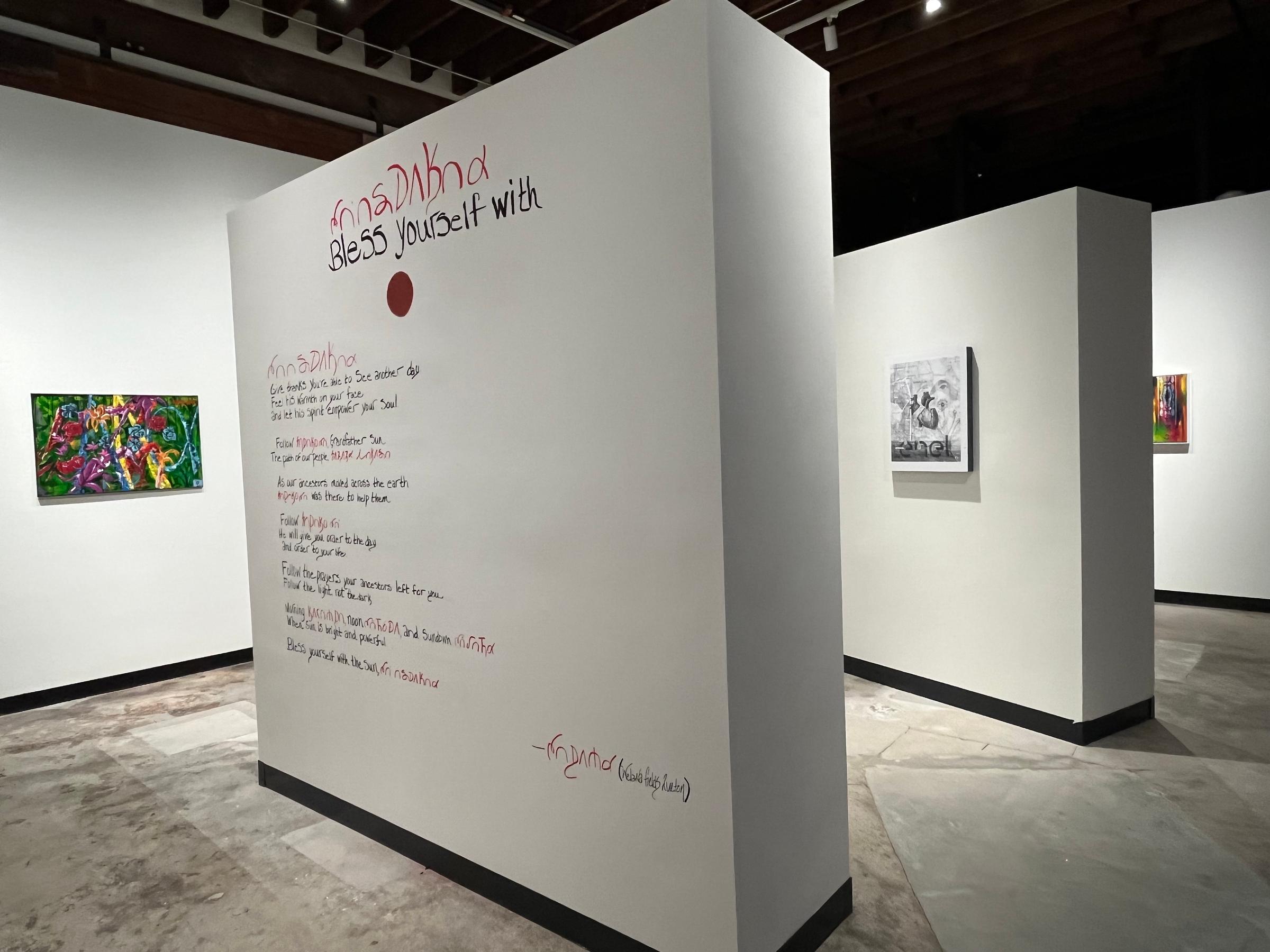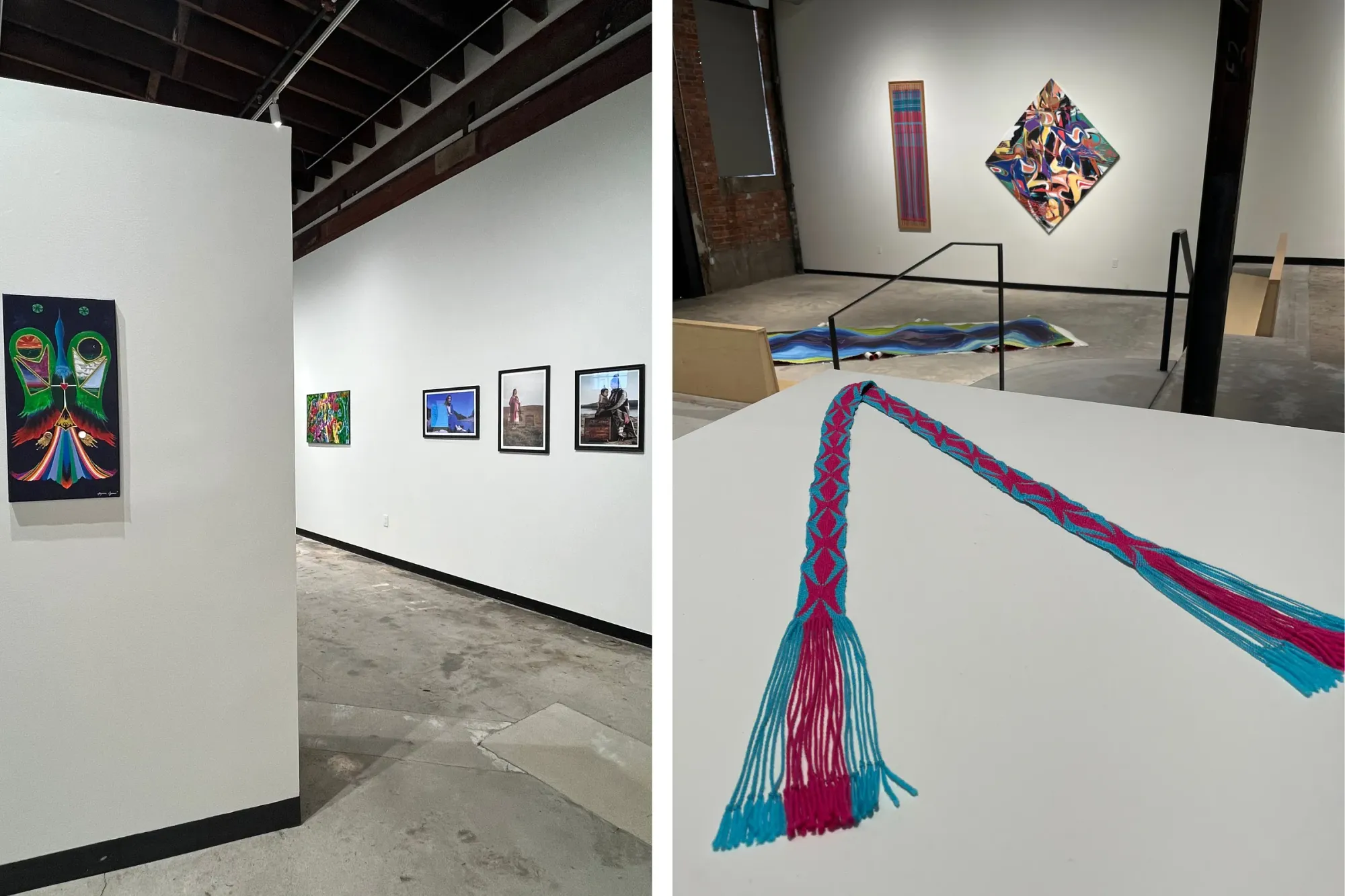𐓏𐒰𐒿𐒷́𐓒𐒷 (Markings): 𐓏𐒰𐓓𐒰́𐓓𐒷 𐒻́𐒷 poetic forms
Tulsa Artist Fellowship Flagship
Tulsa
Through Aug. 10
Standing in 𐓏𐒰𐒿𐒷́𐓒𐒷 (Markings): 𐓏𐒰𐓓𐒰́𐓓𐒷 𐒻́𐒷 poetic forms, the current exhibit at the Tulsa Artist Fellowship Flagship space, I feel as though I’m actually inside a poem — which makes sense, given that exhibit organizer Chelsea T. Hicks is a poet, specifically an Osage “text-based experimental visual artist” who often works in the space of reclaiming her native language.
In Osage, the word translated as “markings” refers not just to “writing” but to photos, designs, patterns, books and other forms of mark-making. This multidisciplinary, Osage-community-generated show reaches across all those spectrums, from a swirling, kinetic painting by Yatika Fields to Julianna Cote’s fingerwoven spider pattern sash to Brian Hicks’ seven variations on the theme of woodgrain, which sit quietly in a circle and grow more complex the closer you look, like they’re revealing the little-heard languages of the trees themselves.
The works gathered for this exhibit touch into the Osage language from many sides. In an artist statement, Chelsea T. Hicks writes that these are “works capable of guiding the creation of new poetic forms” for Osage writing, “forms which do not come from Western traditions, but instead … which might emerge out of our oral traditions.” Written in chalk on one of the Flagship’s pillars are the words “Land Back” and “Language Back”: reclaiming one goes hand in hand with reclaiming the other. Sovereignty and expression go together, as markings become a declaration of presence, living memory and co-creation with nature, history and community.

The sensitive arrangement of this exhibit means you literally walk among the “marks” in space made by the modular gallery walls. Their lines radiate on soft diagonals, so that you can see what’s on them and what’s beyond them at once; one visual field opens onto others like a turn in a well-told story. Traveling through these non-linear pathways, I experienced individual works almost as words in a verse being created by the group of artists as a whole. Sometimes what’s beyond is blocked by a wall itself, making a resonant gap, almost a pause; the rhythm and meaning of that “verse” shifted as I did.
One example: as I stood beside the loosely torn paper edges, taut forms and gestural scribbles in Anita Fields’ Move Forward #1, #2, and #3, my eye traveled across to Chelsea T. Hicks’ Dissolving land-connection, whose blue threads gradually slip out of a tight weave at the top. The wave patterns of those threads pulled on my memory. I saw them before, just over my shoulder, in one of the woodgrain pieces. And I saw Moira RedCorn’s Moving to a New Country, which I’d viewed behind those pieces when I first entered, differently now, noticing how a densely handwritten story in Osage and English follows the curves of this spectacular landscape of layered earth and sky. On the floor below Dissolving land-connection and Yatika Fields’ Abstraction, Wendy Ponca’s Water is our Blood similarly pools and flows: a painted woman’s body stretched within a rippling stream, its underside painted red, undulating over PVC pipes on a strip of shimmering Mylar.
Another: at the very edge of one wall, Norman Akers’ Lines of Sorrow shows the shapes of heart, rain and flowers against the hard backdrop of map, government and dollar. Go around to the other side and you’ll find Pray by Mia Jones, holding intense space at the wall’s other edge. Widen your lens and, like a release after a crescendo, Osage Garden by Dave Cote and three photographs by Mary Hammer, Cody Hammer, Aimee Inglis, Emmrie Mashunkashey and Chelsea T. Hicks spill into view beyond it, as if gently completing the phrase.


There’s so much texture in these “markings”: surfaces of broadcloth and gold, ink and limestone, fur and feathers, light and water. Painted brushstrokes are heavy with iridescence and movement. Color, carving, familial relationships, poetry, a blooming garden, handwriting, documentation, stitching — all can be expressions of this generative language. “As a two-spirit individual,” said contributing artist Alex DeRoin in an artist statement, “I find profound resonance in the Osage worldview, where … our creator resides within everything and everyone…. This exhibition feels like a bridge between ancestral knowledge and a future brimming with possibility.” (The zine that accompanies the show is a work of art in itself.)
As a non-Indigenous person, I found myself aware of what marks my own steps were making in the room, considering how to move thoughtfully in this space. Next to DeRoin’s Doorway—a black door onto which Osage attendees are invited to make their own markings in colorful chalkboard paint — a printed statement about the piece guided my approach to this powerful and innovative show. “For our non-Osage visitors, we invite you to experience the beauty of this collaborative artwork through a lens of appreciation,” it reads. “By witnessing the creative process, you become part of a silent dialogue, honoring the artistic sovereignty of the Osage people. Together, we can celebrate the enduring spirit of Markings, and the ongoing process of reclaiming and revitalizing Indigenous cultures.”

𐓏𐒰𐒿𐒷́𐓒𐒷 (Markings): 𐓏𐒰𐓓𐒰́𐓓𐒷 𐒻́𐒷 poetic forms is on view at the TAF Flagship space through Aug. 10. Stop by on First Friday, Aug. 2, for a salon reading within the exhibit, hosted by John Parker.






